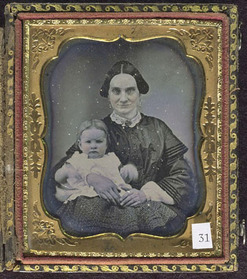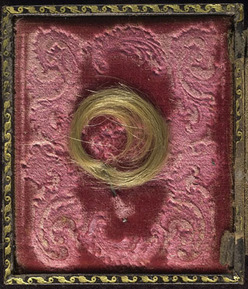A Daguerreotype in a decorative case 19th Century
Daguerreotype 'Portrait, Woman and Child, & Lock of Hair' 1840 -60
All Photographs are captured moments in time - a memory given physical form. Early photographs (see the Daguerreotype above) were often placed in decorative cases and sometimes included a lock of hair. This turned the photograph into an actual object, and like the lock of hair, the image had a direct relationship to the subject.
'Hale County, Alabama' 1936
A documentary within a documentary, this picture suggests the way an Alabama tenant family lived, and, in the two snapshots tacked to the wall, bears witness to the family's informal documentation of its own experiences. The photograph was taken by Walker Evans in 1936, while he was employed by the Farm Security Administration; it was the powerful and moving record of rural poverty made by him and his FSA colleagues that popularised the term documentary photography.
Walker Evans - Penny Picture Display, Savannah, Georgia 1936
In this photograph by Evans he has photographed a set of Photographs. This is something he returned to again and again - the layers build up and you are looking at an image of an image. It is a shop window display in a penny photo arcade - people would go in to have a portrait taken as a memory. We photograph ourselves to prove we existed - we were here. These original images are not art in themselves but Evans photographs them and draws our attention to them. The act of using the work of others is know as Appropriating.
Walker Evans 'Postcard Display' 1941
In addition to photographing displays of photographs Evans also collected photographs - Especially Postcards.
Walker Evans photo of photo
'Tattoo Parlor, NYC' circa 1958 by Robert Frank from 'The Americans'
Album Cover for the rolling stones 'Exile on Main street'
Robert Frank exile on main street
Christian Boltanski 'A reserva dos suiços mortos' 1991
Peter Blake - The Toy Shop 1962
Blake was interested in a wide range of cultural forms, from high art to pop music and children’s toys. Like many young ‘Pop’ artists of the time he was fascinated by American popular culture, such as denim jeans and the music of Elvis, which arrived in Britain in the late 1950s.
Alongside this, Blake retained a strong interest in English popular culture. His work suggests a sense of nostalgia for the paraphernalia of his childhood. Blake collected old toys and related imagery; this piece developed as both a work of art and a store for his collection of objects. Peter Blake












